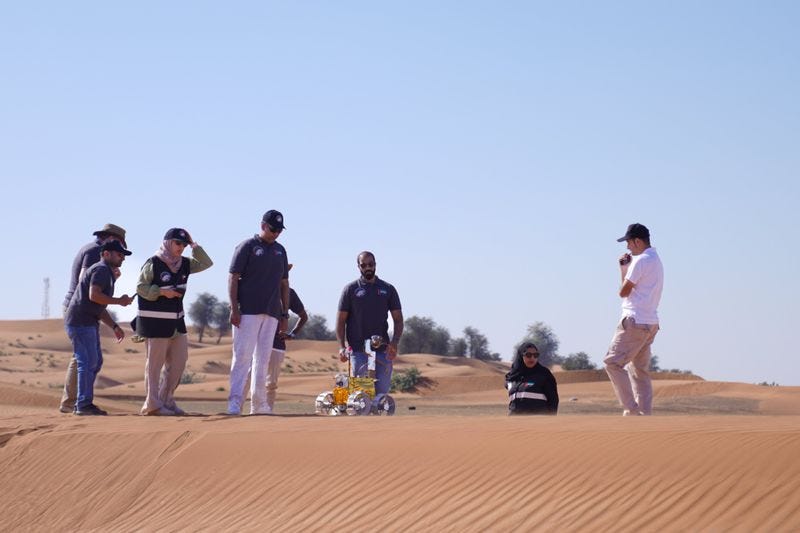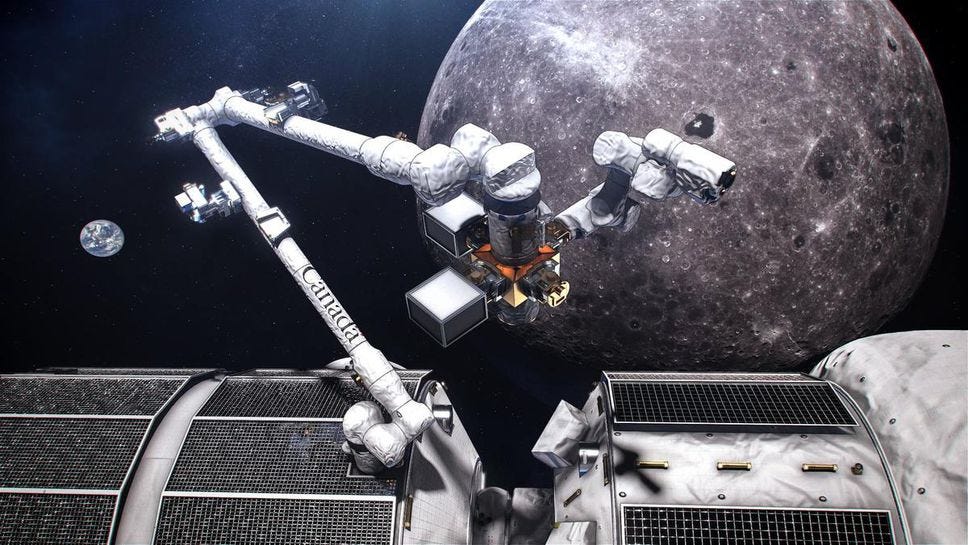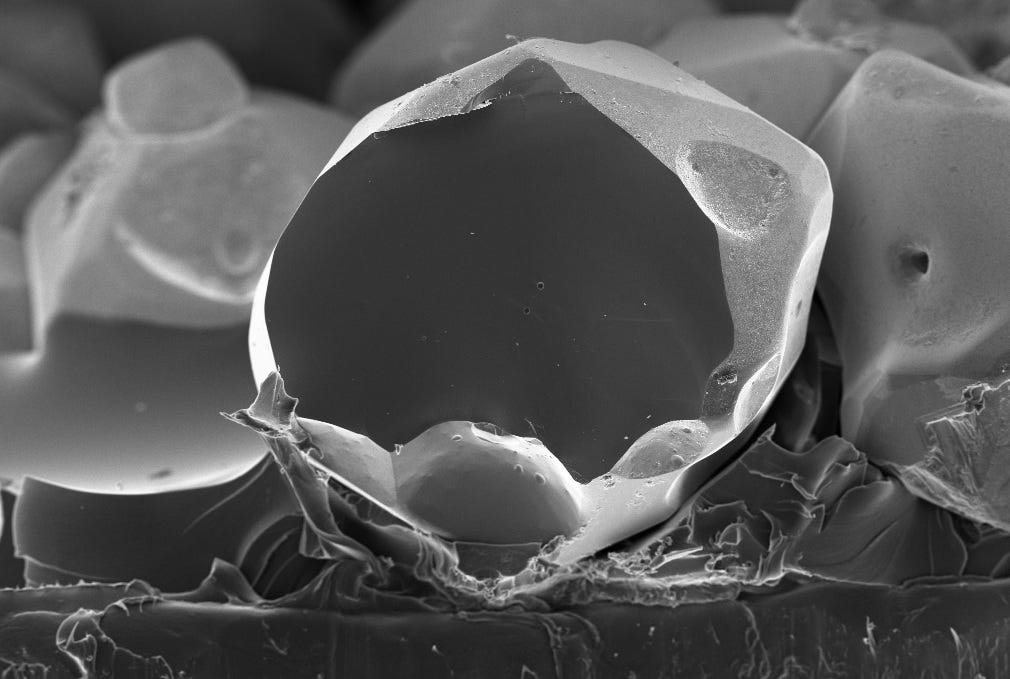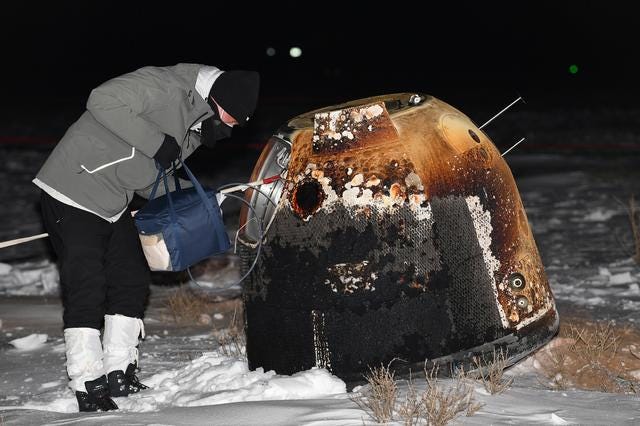Toy robots and oxygen farming on the Moon
This issue is a bit delayed due to my own time constraints this month. For that reason, instead of covering the full breadth of coverage for the month, the following are my selection of lunar industry highlights from March.
In this issue:
14 private companies + 1 consortium
13 countries + the EU
5 public-private partnerships
3 oxygen farming initiatives
3 lunar communications announcements
2 economic predictions
(Opinions and analysis are my own)
Takara Tomy, a Japanese toy company, who originally created the Transformers toy line with Hasbro, revealed a small transformer-type lunar robot nicknamed SORA-Q, which the company jointly developed with JAXA, Sony, and Doshisha University over the last 6 years. It is to be deployed on the Moon during JAXA’s SLIM mission sometime this year.
At about 8 cm (3 in.) in diameter and weighing roughly 250 g (0.5 lb.), the ultra-compact rover is bluetooth-enabled, equipped with front and rear cameras, and contains a battery that will last about 1-2 hours. In Japanese, “sora” means sky or the heavens (universe), and the “Q” is derived from the fact that the robot’s side silhouette resembles the letter "Q”.1 2
Kongsberg Satellite Services (KSAT), a Norwegian provider of the most extensive satellite ground station network globally, announced plans to establish an antenna network dedicated for lunar communications to serve “the growing demand as more lunar missions are launched,” according to Arnulf Kjeldsen, EVP of Strategy & Technology at KSAT. He said, “we see the emerging lunar and cislunar markets as areas where KSAT´s experience can be used to establish an integrated and cost-effective ground station service…Lunar comms is a natural next step for us.”
Spotlight: KSAT
KSAT is part of a consortium selected by the European Space Agency to design the infrastructure for a commercial service offering lunar communication and navigation via a lunar satellite constellation.
KSAT will provide ground station support for one of the commercial payloads launching on NASA’s Artemis 1 mission sometime this year.
KSAT entered an agreement with Intuitive Machines for the US lunar lander company to use its antennas for its first mission, which is planned to launch this year, as well as for future missions.
In addition to KSAT, two other companies contributed to a wave of announcements about lunar communications this month.
Aquarian Space, a US-based startup, raised $650,000 USD in seed funding to develop and deploy a lunar satellite by 2024 as part of a vision to establish a high-speed communications network for the Moon. CEO Kelly Larson predicts 200 spacecraft will be operating on and around the Moon by 2030, “creating a multibillion dollar lunar economy.”
Lockheed Martin, the US aerospace giant, also shared plans to launch a lunar communications satellite in 2024. In addition to linking to the company’s planned lunar rover, the satellite may be used for US military applications in cislunar space, according to company officials.
The US Air Force Research Laboratory (AFRL) closed submissions on April 1 for ideas from industry regarding the development of spacecraft to monitor cislunar space. The AFRL also released a video this month about its Cislunar Highway Patrol System concept, which aims “to improve the United States Space Force's ability to track and identify artificial objects around the Moon.”
MDA, a Canadian space technology company, received $269 million Canadian dollars ($215 million USD) to design its AI-based robotic space arm, Canadarm3, which will be attached to the Lunar Gateway, a planned lunar orbital space station.
This month, MDA unveiled plans to construct its “Space Robotics Centre of Excellence” in Brampton, Ontario by the end of 2022. The 200,000 square-foot facility — which was supported by a $25M grant from the Ontario government — will feature “state-of-the-art labs, manufacturing, R&D, and assembly, integration and test facilities.” The facility will bring 700 high-skilled jobs to Brampton. MDA has 2,200+ employees across Canada, the US and the UK.
The Mohammed Bin Rashid Space Centre’s Adnan Al Rais told The National at the World Government Summit in Dubai that there’s an “international plan to invest a lot on the Moon.” He said local companies in the UAE who want to be part of lunar missions are getting involved, which is “creating jobs, helping develop technologies locally and will help bring skills to the country.” The National reported that the lunar market is estimated to pass $170 billion by 2040, a figure from a PwC report.
MBRSC recently conducted a field test of its lunar rover in the Dubai desert. That rover is planned to reach the Moon as early as Q4 2022.
PwC, one of the Big Four accounting firms and the second-largest professional services network in the world, is also providing technical and project management expertise to a consortium of organizations aiming to send an Australian-made rover to the Moon by 2026.
McKinsey & Co., one of the Big Three management consultancies, is also recognizant of the emerging lunar market. In a video published by McKinsey this month, associate Jess Harrington said, “the cislunar economy could be several different things…… this could be things like manufacturing in space.”

South Korea’s Ministry of Science ICT will recruit experts from industry and academia to research and plan the development of a lunar lander that would target a launch in the 2030s. The lander, which will begin development in 2024, is expected to weigh over 1.5 tons and launch on a South Korean rocket. The mission is a follow-up to the country’s lunar orbiter mission planned to launch this August.

The European Space Agency (ESA) selected an industry consortium led by Thales Alenia Space, and made up of AVS, Metalysis, Open University and Redwire Space Europe, with making a compact piece of equipment to extract 50-100 grams of oxygen from lunar regolith to be used as propellant for spacecraft and breathable air for astronauts, as well as metals to construct equipment. The exercise is intended to evaluate the prospect of building large-scale solar-powered plants on the Moon that can extract oxygen from soil, termed as “oxygen farming”, which would allow lunar astronauts to “live off the land”.
Lunar regolith is made up of 40–45% percent oxygen by weight and it has been theorized that the Moon’s top layer alone has enough oxygen to sustain 8 billion people for 100,000 years.
In another example of resource utilization, iron and sulphur retrieved from the lunar surface could produce pyrite, which has micro crystals that could function as the light absorbing layer of a tiny solar cell. Since 2021, ESA has been working with Estonia’s Tallinn University of Technology (TalTech) on this very concept.
Rolls-Royce, the British engineering firm, received £249,000 ($327,000 USD) in funding from the UK Space Agency to manufacture an autonomous power station for space that could be used to generate water, breathable oxygen, and fuels on the lunar surface.
China National Space Administration’s (CNSA) chief designer for the country's lunar exploration program said that the fourth phase of the program has been approved and will be carried out across 3 missions before 2030.
Chang’e-6 (~2024): A sample return from the lunar south pole.
Chang’e-7: As one of 5 spacecraft on the mission, a small flying probe is to be deployed to survey the bottom of a 10km+ deep crater for lunar ice.
Chang’e-8: Testing technologies, such as extracting oxygen from lunar regolith and 3D printing structures from melted lunar regolith.
The missions are intended to lay the ground work for an international research station at the south pole, which is planned to be constructed by 2035.
Chinese scientists this month identified more than 40 chemical elements in the lunar soil samples returned to Earth from it’s 2020 lunar mission, Chang'e-5. The research team is focused on finding water and Helium-3, and experts said this discovery will guide efforts regarding the extraction and use of lunar resources.
Romania, Bahrain, and Singapore became the 16th, 17th, and 18th countries to sign the US-led Artemis Accords, an internationally shared framework on the principles for lunar exploration activities among governments participating in the Artemis Program, which aims to return humans to the Moon within the decade.
Image of the Month
Airbus’ Pléiades Neo satellite snapped an image from space of NASA’s Space Launch System (SLS) megarocket, after it was moved to the launch pad at Kennedy Space Center this month ahead of its Artemis 1 lunar mission.

You can now read Lunar Business Review in the new Substack app for iPhone!
With the app, you’ll have a dedicated Inbox for my Substack and any others you subscribe to. New posts will never get lost in your email filters, or stuck in spam. Longer posts will never cut-off by your email app. Comments and rich media will all work seamlessly. Overall, it’s a big upgrade to the reading experience.
The Substack app is currently available for iOS. If you don’t have an Apple device, you can join the Android waitlist here.
Disclaimer
The author of this newsletter is employed by ispace, inc. However, this is a private activity and all opinions and analysis are my own. The view expressed should in no way be taken to reflect the official opinion of ispace. This report does not constitute a sales offer and in no event shall it be liable for any investment decision based on the information included in this report. I cannot guarantee that the information included is accurate or complete. Please read the full ‘Disclaimer’ in the ‘About’ section.
Japanese toy maker unveils mini moon exploration robot; NHK, Mar 16 2022.
おもちゃの発想が宇宙探査で活躍!; Takara Tomy, Mar 16 2022.










